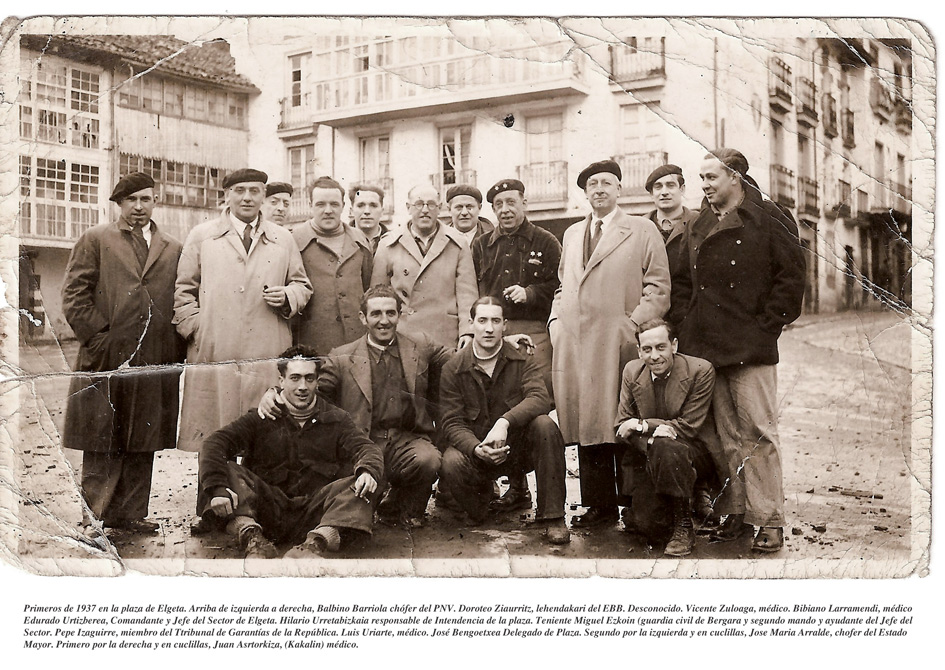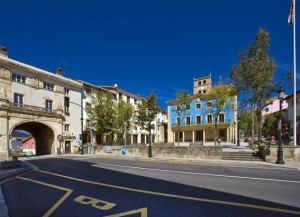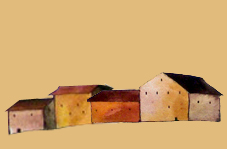 The Provincial House in Elgeta (Gipuzkoa). Photo Garikoitz Estornés Zubizarreta, 1989. Source: Encyclopedia Auñamendi
 Elgeta according to a nineteenth century lithograph (Courtesy Juan San Martin). Source: Encyclopedia Auñamendi
|
Elgeta History
In the Middle Ages, people began to settle Ubera area around the villages of Jaolatza and Olaegi, who are on the way to Bergara. Near these villages are the remains of the Sanctuary of Our Lady of Uriarte is the first Christian place of worship that have news in the area and dating from the fourteenth century. The town of Elgeta was founded in the fields of Maya by the king D. Alfonso XI (the field name inspired the christening of our house). King Alfonso XI extends the Town Charter of foundation of the town on September 13, 1335 in Valladolid and in the same, granted the privilege of Vitoria. The foundation is done in Maya lands. The letter says; The town was fortified by the common function of defense, was a place on the border of Biscay, and demarcation of jurisdiction. In 1338 are given privileges to promote livestock, these were ratified in 1371, which left him outside the economic booms in the thirteenth and fourteenth centuries were the booms of the forges and iron trade in wool and Spanish. The need to attract people to populate the village was to make themselves certain privileges in Guipúzcoa, would only Fuenterrabia. The importance of the designation in forest production and livestock-based remained Elgeta economy until well into the nineteenth century. Relations with neighboring Eibar suffered a crisis in the fifteenth century when a fight broke out on issues of boundaries, pleitearon years later the place to occupy in the general meeting and the order of voting, it was decided to Eibar awarding the position to the left of the mayor and cast the vote before the representative of Elgeta setaba that right. The war of the Convention (1793-1795) adversely affect the municipality when it was forced to pay estate selling municipal lands. In the seventeenth century parish church, dedicated to the Assumption of Our Lady, was served by a priest and five winners and belonged to the bishopric of Calahorra (La Rioja). War of Independence, 1808 – 1814, affected the village. The participation was active and to support it had to re-sell community property and came to mortgage the treasure of the Church. This streak continued payments with the Carlist wars that deepened over the economic hole the municipality. In the first Carlist war was the last speech of the suitor before moving to France and the second saw the last attempt to resist the troops Alphonsine. Industrialization would not land elgetarras to mid-twentieth century, although the late nineteenth century opened small workshops. The industrial implementation, following the growth of the regions of Lower and Upper Deva. In 1927 they separated neighborhoods and Ubera Anguiozar joining Vergara. Linking to mountaineering Basque town began May 18, 1924 when it hosted the birth of Navarra Basque Mountaineering Federation. In the civil war front stopped in the town until the spring of 1937. While the north, the slopes that descend to Bergara, fell on the side of the insurgents to the Republican, the urban core and the rest of the party remained loyal to the republic. The front line ran through the road called the awnings (which today is the road linking the town with the port of Kamparzar). The mountains Intxortas were one of the last places he broke the front before making Vizcaya. The fighting was very hard leaving people severely affected the economic damage as both victims. In Elgeta you can visit the Interpretation Center of the Civil War located in the Espaloia. You can also visit the reconstructed trenches in front of Mount Intxorta. The industrial growth that occurred in neighboring municipalities during the Franco dictatorship influenced the municipality and had increased its population to receive people from other regions of Spain. In the late twentieth century and early twenty-first of many companies have been established in industrial estates that have been enabled in the township. The economy of the population is no longer based on the primary sector, from the secondary to have a very important role. The population is predominantly elgetarra euskaldun, talking to the variety of Bizkaia, as in Eibar and the Alto Deba. Text: Encyclopedia Auñamendi
|







